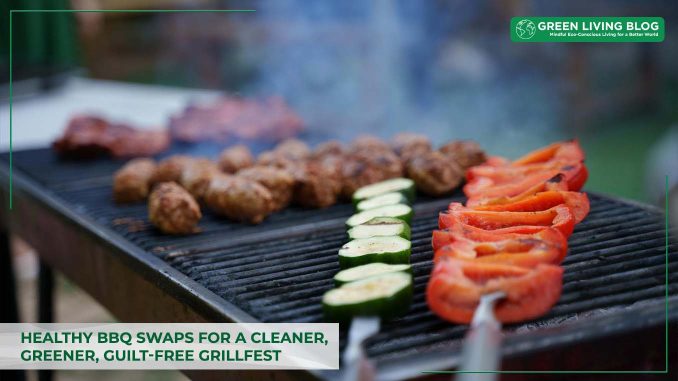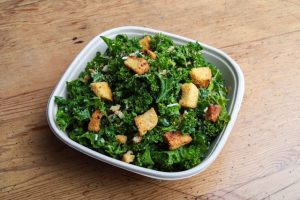
Summer is the ideal time for a barbecue.
Roasting meat and vegetables over flaming briquettes or charcoal adds a certain something to the dining experience that indoor eating can’t rival.
However, the way we barbecue is often not the best for the environment or our health – fatty meats roasted over carbon-laden blocks of fuel increase our cholesterol and carbon footprint.
But before you bin the briquettes and postpone this year’s al fresco dining, take a look at our ideas for a more health-conscious and eco-friendly summer barbecue.
We have eight sure-fire ways to enjoy guilt-free barbecuing this summer.
1. Use Vegan Rubs

By prepping barbecue treats with a bold spicy rub, we give them that heat and flavour that alfresco diners crave.
At the same time, pasting barbecue food with a salty, sugary layer helps to promote the Maillard reaction, which gives grilled treats that seared caramelisation we love in barbecued foods.
Sadly, traditional rubs pack lots of carbs and cholesterol.
Vegan rubs, on the other hand, are often free from refined sugars, preservatives, and fats.
Instead, they’re full of healthy herbs, spices, and other natural plant-based ingredients, providing the eater with the flavour and the health benefits of antioxidants and anti-inflammatory goodness.
And not only are rubs good for our health, but they are good for the environment, too.
The fewer animal products we use in our barbecue, the smaller our carbon footprint.
Rub it in, why don’t ya!
- Paprika: A punchy spice rich in antioxidants like capsaicin, a natural pain reliever, so add it to the menu if you have aches and pains.
- Turmeric: Earthy with a hint of bitterness, turmeric is great on chicken or halloumi and has anti-inflammatory properties and gives your immune system a pick-me-up.
- Garlic Powder: Goes good on steaks and pork, and possesses antibacterial properties, supports heart health, and boosts the body’s immune function.
2. Make Halloumi the Star of the Show
Halloumi, a low-fat cheese from Cyprus, is perfect for barbecuing.
Thanks to its high melting point, it won’t be reduced to a protozoic slime when you submit it to the flames of a barbecue.
In fact, it will stay firm throughout the grilling process and develop a delicious golden crust as it cooks but keep its soft cheesy centre so that once you bite into you get that softness you expect in a cheese.
Halloumi is also a far eco-friendlier barbecue option than meat: where beef can cost 25+ kg of CO2 to produce a kilo, the equivalent amount of cheese typically produces around 6 kg of CO2.
And don’t forget Halloumi is also a great source of protein, calcium, and healthy fats, making it a satisfying yet lighter option for your summer barbecue than most meat options.
It’s All Greek to Me: Souvlaki Style Skewers
If you’re considering serving halloumi, why not go the whole hog and give our guests authentic Greek-style cheesy skewers?
Traditional Souvlaki skewers often feature chunks of Halloumi intermingled with juicy cherry tomatoes, tender zucchini slices, sweet red onion, and pineapple slices.
Bon appétit! Or maybe that should be kali orexi!
3. Learn to Love Hake

Hake has a mild, sweetish flavour and isn’t as ‘fishy’ as some other marine life, so it doesn’t overpower other flavours and nicely soaks up barbecue marinades and seasonings.
You can also eat it in the knowledge that it’s a super sustainable fish.
Indeed, thanks to good husbandry, hake is now considered the UK’s most sustainable fish.
If you want to go the extra mile when sourcing sustainably sourced hake, look for fish caught with gillnets.
Fisheries that take a responsible approach to netting the fish employ gillnets, which use larger mesh sizes than is legally required, allowing small fry fish to swim on by.
4. Ditch the Dogs, Embrace the Carrot
Everyone loves a hot dog at the barbecue, but they’re often processed meat, which means they come high in sodium and larded with saturated fats.
A carrot dog is a plant-based alternative to traditional hot dogs.
Full of fibre, vitamins (beta-carotene, a precursor to vitamin A, important for vision), and antioxidants, the humble carrot is a wonder food.
Roasted right and accompanied by the right relishes and condiments, they will have your guests convinced they’re the real deal.
And they’re sure to be an excellent conversation starter, too.
5. Reverse-Sear Meat for Nutritional Cooking

Let’s face it, as well as the carrot dogs might go down with guests, people still expect meat at a barbecue.
But if you’re going to serve meat, be sure to go for responsibly sourced stuff – avoid beef and go for chicken or, if you’re feeling adventurous, wild game birds.
Game birds have a zero-carbon footprint, are antibiotic-free and culling them helps control natural populations.
And when you cook the meat, be sure to do so in a way that allows it to retain its goodness and nutrients.
Reverse searing is the best way to do just that.
Here’s how:
- Start slow and low: Set up your barbecue for two-zone cooking, where one side of the grill has low heat, and the other side has high heat. Keep the heat on the low side at around 225°F to 275°F. Place your meat on the cooler side of the barbecue, away from the flame, and cook until it reaches just below your target internal temperature. It’s best to close the barbecue’s lid here to ensure your meats are cooked evenly.
- Pause and reset: Once the meat reaches the desired internal temperature, remove it from the barbecue and let it rest for 5–10 minutes. This will help the meat juices redistribute.
- Ramp up the heat: While the meat is resting, turn up the heat on the hot side of the barbecue. If you’re using charcoal, this means adding more coals or spreading the existing coals for a high heat.
- Start the sear: Now blast the meat directly with the high heat side of the barbecue for about 1–2 minutes per side, or until you achieve a nice, golden-brown crust. This high-heat sear will give your meat a perfect crispy outer layer that retains the meat’s nutrients.
6. Vertical Grill to Reduce Oil
Meats are naturally fatty, but we add to the problem by larding them with oils to help them cook.
While this might keep the meat moist and succulent, much of that oil will end up in your arteries, and when poured down drains, might contribute to one of those famous fatbergs that would sink the Titanic.
By using a vertical grill or tower smoker, you add a new dimension – literally – to your summer barbecue.
The meat or fish can be loaded into the grill or smoker and left to hang as it cooks – this does two things: allows excess fats and oils to drip away and helps the natural smokiness of the grill or smoker to circulate and infuse the cooking food.
GLB Picks
- Charcoal Portable Vertical Smokeless Barbecue: A portable barbecue ideal for outdoor cooking. The vertical design is compact and space-saving. (£69.99).
- Premium Charcoal barbecue Smoker Grill: Features a temperature gauge that allows you to keep on top of the heat. Comes with two grill racks, a hanging rack, and hooks for hanging grilling fish. (£99.99)
- Pit Boss Pro Series 4 Series Vertical Wood Pellet Smoke: A wood pellet smoker with lots of space inside, ideal for low-and-slow smoking. The grill comes with digital controls, Bluetooth and WIFI connectivity.(£479.99).
7. Start with Kale: A BBQ Superfood

Grilled kale is a great starter at your barbecue and is super easy to make – simply strip the leaves from the stem, coat lightly in oil, and add salt and pepper as you grill them over the flame.
The kale will go crispy with the oil, and after a few minutes, you have a toothsome starter for your guests to enjoy before the main dish.
Think of grilled kale leaves as the chips or fries of your barbecue – handy little finger food to have around.
Not only is barbecued kale easy to make, but it’s abundant in the UK (cultivated mainly in Lincolnshire, Yorkshire, and Cornwall) and packed with vitamin goodness, too.
It boasts a veritable alphabet of vitamins in its green leaves, including A, K, C, and B6; and it’s also a great source of calcium, potassium, magnesium, and iron.
8. Cook with Sustainable Charcoal
Bamboo, coconut shells, and charcoal sourced from sustainable trees all burn well in a barbecue and take the guilt out of grilling.
Coconut shells are the ultimate recycled fuel – the shells used for barbecue fuel often come from coconut processing in the coconut oil and milk production sectors.
Coconut can also burn 2-3 times longer and a lot hotter than regular wood charcoal, making it more economical for longer cooking sessions.
Bamboo is equally eco-friendly – it is a great carbon sink, so while it’s growing, it’s sucking in lots of the carbon we pump out.
And it starts to regrow almost immediately after it’s harvested and fully regrows within a couple of years.
However, if you go for more traditional charcoal briquettes, try to source them from sustainable sources, ideally ones that have been given the seal of approval by a body such as the FSA.
GLB Picks
- Asado Disposable Bamboo barbecue: The barbecue’s bamboo construction means it’s both disposable and sustainable, ideal for camping trips, festivals, or small-scale grilling. (£4.95).
- Best of British Lumpwood Charcoal (5kg): Made from sustainable British hardwood, this charcoal ignites quickly and is ready to go in just 15 minutes (certification code: Gib-S-WM-5025). (£23.95).
- The ProQ Coconut Shell Briquettes (10kg): A premium, eco-friendly alternative to traditional barbecue charcoal, these briquettes are 100% natural coconut and are free from additives and chemicals. (£28.99).
Fin de Partie
The question we’re left asking post-barbecue is: what’s the most eco-friendly way to dispose of all the waste and mess we’ve produced in hosting the perfect summer garden party?
The good news is that it’s not just the leftover vegetable scraps, fruit peels, and other organic matter that can go to the garden compost.
The microbes and fungi in your composter are the Goldilocks of the bacteria world – they love it when the decaying matter they call home is not too acidic or alkaline, typically around a pH of 6 to 7.
By adding some natural-wood charcoal ash from your extinguished barbecue, you maintain a healthy compost pH and help them dine on your leftovers once your feast has come to an end.
![]()
Author Profile
- Online Media & PR Strategist
- Blogger and Educator by Passion | Senior Online Media & PR Strategist at ClickDo Ltd. | Fascinated to Write Lifestyle Blogs in News & Education I have completed a journalism summer course at the London School of Journalism and manage various blogs.
Latest entries
 BusinessOctober 29, 2025Top 6 UK Government Green Funds & Grants for SMEs
BusinessOctober 29, 2025Top 6 UK Government Green Funds & Grants for SMEs List postOctober 16, 202510 Best Green Hosting Services in the UK
List postOctober 16, 202510 Best Green Hosting Services in the UK BusinessSeptember 9, 2025Top 5 Eco Certifications & Their Impact on Greener Businesses
BusinessSeptember 9, 2025Top 5 Eco Certifications & Their Impact on Greener Businesses LeisureSeptember 2, 2025Plant-Power: The UK’s Top 10 Vegan Festivals 2025
LeisureSeptember 2, 2025Plant-Power: The UK’s Top 10 Vegan Festivals 2025






Leave a Reply
You must be logged in to post a comment.